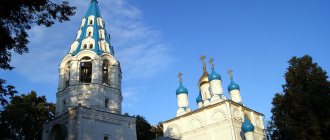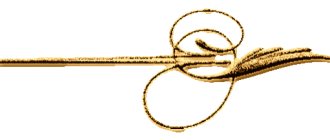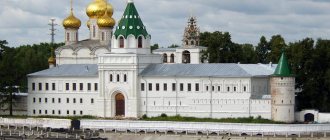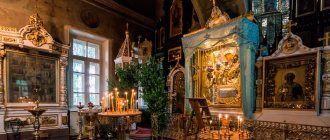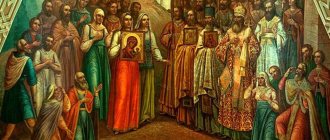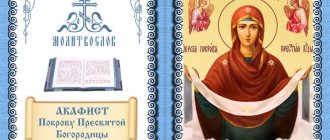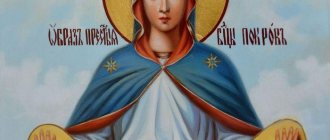As Christian traditions say, the icon of the Mother of God of “Unceasing Help,” like forty other images of the Most Holy Theotokos, was painted by the associate of the Apostle Paul, Luke. From that time until 1453, the image of the Virgin Mary was kept in the temple of Constantinople, until the city was raided by Turkish troops. It was then that the icon was destroyed. Of course, today there are many lists from the original, but, unfortunately, all of them have undergone some, albeit minor, but still changes, and have also been supplemented with new colors. The oldest icons that have survived to this day date back to the 16th century AD. e. On these lists, as on all images of Byzantine iconography, the Mother of God appears before believers in the image of the all-forgiving Mother of God, as the last hope and “refuge for sinful souls,” to which even the most hopeless sinners can turn. The Mother of God, the embodiment of tenderness and severity, holds the Son of God Jesus in her arms and looks at the Christians praying before the image. Baby Jesus looks with frightened eyes at the flying angel, in whose hands he sees his destiny in the form of a crucifix, a spear and the sponge with which Christ was given a drink. The inscriptions on the icon tell us that these archangels are Michael and Gabriel. The background of the image is painted in gold, which symbolizes eternity and God himself. The Mother of God in the “Perpetual Help” icon is depicted in a red robe and a blue cape, where red means love and blue means fidelity and faith. The green color present on the icons of the Mother of God of Perpetual Help symbolizes the divinity of the baby, and his brown robes symbolize the inextricable connection with humanity and the earth, since Jesus is both a man of flesh and the Son of God.
Our Lady of Perpetual Help
Image of Our Lady of Perpetual Help
Our Lady of Perpetual Help is a type of image of the Virgin Mary in Catholic iconography. The iconography of the image includes figures of angels carrying the instruments of the Passion of Christ. A similar iconographic type exists in the Orthodox Church, this is the Passionate Icon of the Mother of God. The Redemptorist congregation especially contributed to the spread of veneration of this image in the Catholic Church.
The iconographic type was developed by Italian and Greek masters in the 15th century. The most famous and revered copy of the icon of Our Lady of Perpetual Help is in Rome, in the Church of St. Alphonsus Liguori (English) on the Esquiline. This icon was brought to Rome in 1480 from Crete and was kept in the Roman Church of St. for about three centuries. Matthew, and since the beginning of the 19th century in the church of Santa Maria in Posterula.
In 1865, Pope Pius IX gave it to the Redemptorist Order and, according to legend, said: “Make sure that this icon is known throughout the world.” Thanks to the activities of the Redemptorists, the veneration of this icon has spread widely in the Catholic world; now there are several hundred churches and sanctuaries dedicated to Our Lady of Perpetual Help, including Catholic churches in the Russian cities of Orsk and Petrozavodsk consecrated in honor of the image. In the 1990s, the Roman image was carefully restored.
There are several small female monastic congregations dedicated to the image. On June 27, the Catholic Church celebrates the feast of this icon.
Theology of the Icon of the Mother of God of Perpetual Help
MESSAGE OF THE ICON
When looking at the image of Our Lady of Perpetual Help, we should always keep in mind that we are dealing with an icon painted by an anonymous author in accordance with the canon of Our Lady of Sorrows, which was used to represent the Christian mystery of redemption.
What is an icon?
The Greek word eikón, from which this term is derived, means image. The New Testament applies this word primarily to Jesus Christ: He is the image of the invisible God (Col 1:15; Heb 1:3). Those who are baptized, identifying with Jesus, also become the image of God and the temple of the Holy Spirit (Rom 8:14). But usually, when we talk about an icon, we mean an image representing Jesus, the Mother of God or saints, depicted in strict accordance with technical and theological canons.
An icon is something more than an ordinary image or a reminder of events and people of the past. The icon makes what is depicted on it really present. It is the point where human reality and the mystery of God meet. Therefore, the icon is not just a decorative element of the altar. She herself is an altar. This explains why in the liturgy of the Eastern rites it is placed in the same place as the books of the Word of God.
An icon is the fruit of prayer. The artists who created the icons created them in an atmosphere of repentance and prayer. As they worked and prayed, they thought about those who would pray before the images they created. This means that icon painters, mainly monks, contemplated the mystery of God and presented the essence of their contemplation in colors. In this way they passed on their faith and spirituality to other believers.
An icon is an object of meditation . When we stand before an icon to pray, we can immerse ourselves in the mysterious reality it represents and gain a deeper understanding of the value of liturgical prayer. Icons were created to aid our contemplation.
Unknown author
Most icon painters are nameless artists. Among the few famous artists who painted icons of Our Lady of Sorrows was Andrea Riso de Candia (1422–1499), who belonged to the Cretan school. The Icon of Our Lady of Perpetual Help belongs to this school, but we cannot give the exact date of its creation. However, with a high degree of probability we can say that he was a monk from Fr. Crete.
An ancient legend attributes the first icon of Our Lady of Sorrows to St. Luke the Evangelist. This is how the authors of the Mother of God icons built bridges between their work and the community of believers who personally knew Jesus and Mary. This legend is more a theological idea than a historical fact, since the painting techniques used in the first centuries of Christianity were very different from those used in icon painting. The oldest icons were painted in the 6th century, and most of the now known icons were created in later times, starting from the 12th century.
Our Lady of Sorrows
The icon of the Mother of God of Perpetual Help is written on a board measuring 54x41.5 cm. Over the centuries, it has received two main names. From an artistic point of view, due to the type of image, it was called “The Sorrowful Mother of God.” Icons of the Mother of God of Sorrows, as a rule, depict Mary holding her Son Jesus in her arms, flanked by angels carrying instruments of the passions.
Another name was born from piety, which gave the icon the name: “God's Mother of Perpetual Help.” In our icon, the Most Holy Mother tenderly looks at her admirers and is ready to rush to their aid in any need.
The icon depicts four holy figures:
The Immaculate Mother of God, the Child Jesus and the holy archangels Michael and Gabriel.
These figures are indicated by the letters on the icon:
MP – ΘΥ = Mother of God (on either side of the top of the image) IC – XC = Jesus Christ (to the right of the Baby Jesus' head) OAM = Archangel Michael (above the angel, to the left of the viewer) OAG = Archangel Gabriel (above the angel, to the right side )
The Virgin Mary is shown from the waist up, but one gets the impression that she is standing. She is dressed in a red tunic, a dark blue cloak (green on the inside) and a blue cape covering her hair and forehead. In its upper part in the middle there is a golden star with eight straight rays, and next to it is a cross with rays, similar to a star. The head is surrounded by a round halo, characteristic of the Cretan school. In 1867, a crown was placed on it, which was removed during the last restoration.
The Virgin's face is seen slightly inclined towards the Baby Jesus, whom She holds in her left hand. With her large right palm with long fingers (characteristic of images like “Hodegetria” - “showing the way”), Mary embraces the hands of the Child. Her gaze glows with tender sadness. Mary does not look at her Son, it seems that She is talking with the one who looks at the icon. Almond-shaped, honey-colored eyes and well-defined eyebrows make Her face beautiful and sublime.
Baby Jesus is the only one depicted in full size. He sits on his mother’s left hand, and with his hands firmly holds Her right palm. He is dressed in a green tunic with a red belt and covered with a reddish cloak. The sandal falling on the right side allows you to see the bottom of the foot. This may mean that the Child is struck by the vision of the passion caused by the cross and nails, which the Archangel Gabriel shows. On the other hand, the archangel being God, Jesus is also a man. He has brown hair and childlike features.
The feet and neck express sudden movement in fear of something that is about to happen. Obviously, Mikhail shows other instruments of passion: a spear, a pole with a sponge and a vessel with vinegar.
The Mystery of the Redemption
The Icon of Our Lady of Perpetual Help is not a decorative element, it is an image that carries a certain message. This is a catechesis that explains the main mystery of our faith. The various elements shown in it tell us about God present among us, about the Way of the Cross, about the loving intercession of Mary and about the radiance of the coming glory (golden background of the icon).
In the body of Mary, the covenant of salvation took on concrete features when the Son of God took on our human nature. And when His earthly life ended on the cross, Mary was there as the first follower of the Teacher. It was in these last minutes that Jesus declared Her to be the Mother of all believers: “Behold your Mother” (John 19:27). Mary accepts us as her children to lead us to Jesus.
The largest figure on the icon is Mary, but the figure of Mary is not the key point of the image. In the center of the icon are the joined hands of the Mother and the Child, depicted in such a way that Mary is pointing to her son Jesus Christ, the Son of God, who sacrifices his life for us all. Before us is the type of icon that is called “Hodegetria,” that is, “showing the way.” Mary shows Christ who is the Way, the Truth and the Life (cf. John 19:25).
The Child Jesus is shown as a sacrifice prepared for the offering, which will take place as the evangelist describes in the scene of the Sacrifice in the Temple (Luke 2: 22-40). And the way the Mother of God stands reminds us of the words of the Gospel, “At the cross of Jesus stood His Mother” (John 19:25), not broken by pain, but standing firmly and vigilantly.
All elements of the composition emphasize the reality of suffering, which is expressed on the face of the Mother, in the sharp movement of the Child Jesus and in the presence of instruments of passion. However, at the same time, the triumph of Jesus is emphasized, indicated by the golden background and how solemnly the angels hold the instruments of the passion. They seem as much instruments of execution as trophies of victory; It was as if they were taken from Golgotha on the morning of the Resurrection.
It is clear why the image of Perpetual Help calls for prayer. After all, it contains the whole Mystery of Redemption. It is also not difficult to understand why so many people like to recite the Rosary in front of this icon. They see in her not only Mary, accompanying them in life and prayer, but also contemplate the mysteries of the life of Jesus: Joyful (Child), Sorrowful (Cross) and Glorious (golden background of the icon).
Prayer
We come to see You on the throne of Your mercy And with confidence we pray to You And we call on Your Son. We trust your heart Our illnesses and needs: Mary, oh Mary, Mary, help! O Mother, one day in our death, In our last need, Help us find happiness, By drinking the joyful cup of death. When the eyes are almost closed, let me say to my heart and lips: Mary, oh Mary, Mary, help us!
We will be glad to receive any kind of monthly help - this will allow us to feel more confident and make plans for our work more reliably - DONATE
In front of which icon of the Mother of God what do they pray for?
It is generally accepted that it does not matter which icon you pray in front of, as long as you do it with a pure heart and good intentions. We pray and venerate not a specific icon, but the one who is depicted on it.
However, there are known cases when the Mother of God herself appeared to the sick and suffering in a dream or in reality and told which icon to pray in front of in order to receive healing from an illness, and where to find this icon.
Many people received healing from prayer in front of the icons of the Mother of God.
All these miraculous healings were recorded and now we know what kind of healings specific icons of the Mother of God became famous for.
Also look at the icons of the Mother of God by celebration date; perhaps some icon of the Mother of God is celebrated on your birthday. Prayers and special veneration of “one’s own” icon of the Mother of God (coinciding with one’s birthday, or the next after it) are considered by many to be especially important.
Icon of the Mother of God “Gracious Heaven” - they pray for guidance on the path leading to salvation and inheritance of the Kingdom of Heaven - the day of celebration is March 6 (19).
Interpretation of the image “Impenetrable door”
The icon of the Mother of God has a complex multi-figure composition based on the liturgy of John Chrysostom “The impenetrable door is secretly marked...” and the stichera of Sergius the Patriarch “Even the door, born to the east, awaits the entrance of the Saint.” And the Fathers of the Church, in turn, were guided by the text from the Book of the Prophet Ezekiel: “And the Lord said to me: The gate is shut... and no man can enter, for the God of Israel has entered through them” (Ezek. 44:2).
The drawing consists of three levels. On the top one is depicted God the Father - a gray-haired old man sitting on a cloud. A ray of light emanates from it, where a white-winged dove hovers, personifying the Holy Spirit and the sacrament of the Immaculate Conception. In the center of the image is the Virgin Mary in the hypostasis of Oranta - with her hands raised in a gesture of prayerful protection. Sometimes Her silhouette includes the baby Jesus in a mandorla - an oval halo that emphasizes the immaterial nature of Christ. The Heavenly Queen stands on a dais, and behind Her is the portico of the temple (symbol of the entrance to heaven). There is also another, very rare version of the image of the Virgin Mary - in a crown and mantle, with a sword and the Gospel. On both sides of the Madonna are depicted apostles, martyrs and prophets praising Her dignity. And below you can see figures in funeral shrouds, languishing in a gloomy dungeon. The meaning of this element is the expectation of the Messiah, who gives hope for eternal life, forgives sins and leads souls from hell.
The relic represents several theological positions at once. First of all, it points to the purity of the spirit and body of the Virgin Mary, illustrates the miracles of the Incarnation and the Nativity, as well as the hope for the Second Coming. The icon also reminds us that the only path to heavenly bliss is following the Lord’s commandments, and the Mother of God is always ready to support a person in his attempts to reject temptation!
This shrine is classified as an akathist shrine - created based on chants of praise in honor of the Madonna. There are other similar works - “Joy to All Who Sorrow”, “Unfading Color”, “Seeking the Lost” - but even among them the image of “The Impenetrable Door” stands out for its deep meaning and sublimity. An icon made of Polesie gems looks especially spiritual - such a picture made of amber will allow you to completely renounce everyday worries, indulging in sincere prayer.
The Mother of God will help everyone. An icon that brings faith and hope to our hearts
Very often in childhood, we could hear from old people that in case of any problem or illness, we should always turn to the Mother of God with a petition. Many people have only general concepts about the Great Intercessor of all humanity, but has anyone ever wondered what kind of person this woman was, how she lived and what she looked like? As we can see, the Mother of God, whose icon almost everyone has, is quite pretty, and her gaze can reach to the very depths of the soul.
Meek woman
It is enough to pay just a little attention to searching for interesting information, and you will forever remain fascinated by this great image. After all, Mary was born ordinary people - just like all of us. But what could influence the holiness of this girl-woman so that she could become the chosen one among all past and future generations of humanity?
Most likely, this will remain known only to God, but we have received great memory and help in any situation, even the saddest. It is not for nothing that the Mother of God loves us. The icon was given to us for closer communication with her and to receive an answer. You just have to believe - and miracles will certainly come into your life.
Earthly helper
The Virgin Mary loves all humanity so much and worries about us that she stayed with us on Earth and helps everyone in need with her love in every possible way. The help of the Mother of God herself, believe me, is a great miracle that can radically change your life for the better.
The world was given multiple faces of Holy Mother, who always hears our prayers and asks for us before God, even for the most unworthy sinner. The Mother of God helps everyone. The icon represents a kind of window into another world, where you will be heard and always helped.
The main thing is not to forget about this, and Mother will guide you throughout your life. Her angels are always present next to you and help in any life situations. Not only is she with us on Earth, but she has also brought a whole army of her angels to help all those in need.
Image of the Virgin Mary
No wonder she is the queen of angels - Cherubim and Seraphim. And of course, everyone knows the angelic song praising the Great Intercessor: “O Virgin Mary, rejoice...” With this song, contact with great power begins. The Mother of God (the icon with her image is a kind of symbolic window or entrance to the world of love and miracles) is always ready to listen and help.
There are a lot of icons dedicated to the Mother of God herself and her earthly life all over the world. But the very first one was written by the Apostle Luke. He was famous for his talent for painting. The first image, according to legend, was written on a board that served as a dining table for the Holy Family. The Mother of God herself blessed her image and ordered to pray to it for quick help.
One of these icons is “Vladimirskaya”. Although the original image has not survived, multiple copies of it are also filled with the miraculous power of love and goodness. The Day of the Icon of the Mother of God of Kazan falls on November 4.
Have you ever wondered what Mary looked like during her lifetime? Icons adhere to a certain style that was long ago accepted in icon painting. Sometimes the image may change, but there are no significant differences. From the icon of the Mother of God, a photo can easily convey that very ray of love and tranquility that every person so needs. Even if you don’t have images, look at the images, this will be enough to establish contact with our great Intercessor. According to the surviving descriptions of Christ’s contemporaries, the appearance of the Mother of God is indeed similar to the images on the icons.
How does an icon help?
This is what they ask before this face of the Virgin Mary:
- resolve misunderstandings between relatives, children and parents;
- maintain the fidelity of spouses, strengthen family ties, prevent infidelity and quarrels;
- soften hearts and reconcile disputants;
- protect household members from slander, slander, and bad intentions;
- protect from corruption, temptation, envy, anger, depression and despondency.
In addition, those who are worried about the safety of their home should buy the “Impenetrable Door” icon - it prevents visits from unwanted guests, fires, floods, robberies and other disasters. The image will not allow any misfortunes to happen to you or your loved ones - you just need to rely on the will of the Creator.
It is interesting that this relic is also used as a cell relic. She supports monks and nuns who observe the vow of celibacy and chastity, helps strengthen their faith and overcome doubts.
Prayer to the “Impenetrable Door” icon
O All-Merciful Lady, Virgin Mother of God! Hear our humble prayer: (request) and lift up to your Son and our God your motherly prayer for the servants of God (names) living in this house, that He may not cast away their sinners from His presence, but as He is merciful, may He forgive them their sins freely and involuntary, may they save them from the temptations of the world, from the snares of the devil and from the attacks of visible enemies, may they create good and serene days, for the Lord is good to all creation, with the Father and the Holy Spirit, glorified forever and ever. Amen.
Other icons of the Mother of God, in front of which it is customary to pray for deliverance from the epidemic:
- Icon of the Mother of God “Seeking the Lost”
- Icon of the Mother of God “Vsetsaritsa” (“Pantanassa”)
- Icon of the Mother of God “The Sign” Novgorod
- Icon of the Mother of God “The Sign” “Tsarskoye Selo”
- Icon of the Mother of God "Jerusalem"
- Icon of the Mother of God “Kazan”
- Icon of the Mother of God “Protection of the Blessed Virgin Mary”
- Icon of the Mother of God “Healer”
Kursk-Root Icon of the Most Holy Theotokos “The Sign”- Icon of the Blessed Virgin Mary “Kosinskaya” (Modenskaya)
- Icon of the Most Holy Theotokos “Look at Humility”
Icon of the Most Holy Theotokos “Passionate”
